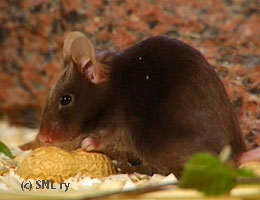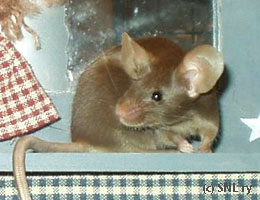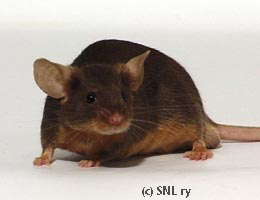Genetics
B-locus
B Locus
B-series, or black/Brown locus.
This series controls whether black pigment on a mouse is black or brown.
1. Full black colour B
This is the dominant allele in this locus, and the unmutated one. It isn't necessary to look at this allele closer, as it is, actually, done within theA-locus already.
Anyway, here are some varieties with full colour B - With agouti A: agouti, with black-and-tan at: black tan, with non-agouti a: black.
Of course there are others, but these are discussed closer with C-locus and P-locus.
2. Brown dilution b and Cordovan bc
Both these alleles are discussed together for one reason: when, in mouse standards, you see "b", the gene is in fact bc. Confusing? Well, maybe...
The gene normally "used" or available by mouse breeders is the bc, cordovan. This gene dilutes the black pigment to deep brown colour. This is what makes the chocolate mouse colour so delicisous. bc is dominant over b, so the presence of b can go unnoticed for quite some time. The 'basic' b-dilution brown colour is just, well, brown. In my experience, the "plain b" is mostly seen in pet shops and pet-typed mice. Of course, situations differ from one location to another. Usually plain brown can be told apart from the chocolate brown cordovan with ease.
As the genetics section deals with mouse fancy aiming towards standards, I'm basically leaving dealing with b out.

Chocolate (cordovan), a/a bc/* |

Chocolate (brown), a/a b/b |

Chocolate sable, Ay/at bc/* U |

Chocolate tan, at/at bc/* C/* D/* P/* |

Chocolate, ae/ae bc/* C/* D/* P/* |
2.1. bc combining with Ay
When dominant yellow mice have bc/*, the deep red colour is not affected. However, because these mice quite often have some degree of sootiness, the presence of bc/* helps to "wipe out" this sootiness by diluting the unwanted black colouring into not-so-well noticeable chocolate.
With b/b, the red mouse would have dark ruby eyes.
2.1.1. The Chocolate Sable Ay/* bc and the Chocolate Marten Sable Ay/at bc cchcch
As mentioned before (see A-locus), there can be other sable colours than the black background one. The chocolate sable is one of these other sables. I have had chocolate sables in my mousery and I have to say they aren't very striking, do not differ enough from the regular sable and thus aren't actually "worth" breeding and definitely not worth standardizing. When the back on a regular, black-based sable is as dark brown (or, sepia) as possible, this will be diluted by the bc-gene to a lighter shade. Genotypically, this mouse is chocolate sable, but phenotypically (= what the mouse looks like) it is just a poor, too light (back and shading) sable...
What about chocolate marten sable, then? I would say that the chocolate marten sable has the same kind of "problems" as the chocolate sable mice - they look like too light and ruddy martens. The chinchilla factor present in this variety does not effect the depth of chocolate pigment at all. (see c-locus, cch)
2.2. bc with A
When bc/bc is combined with the agouti A, the result is so called chocolate agouti - which we all know as cinnamon. This is caused by all the black pigment present in the agouti diluting into chocolate, both the base of hair and the ticking.
2.3. bc with at
As I have stated before, the brown dilution has not much of an effect on yellow (red) pigment. Thus, when combined with the tan gene at, the result is chocolate brown top and fiery tan belly. As a matter of fact, the chocolate tan is much easier to breed than the black tan, because some of the faults present so not show. These faults include throat spot of the top colour, as well as top-coloured base of hair in the belly. In the chocolate tan this colouring in the base of the hairs will actually give a little more depth to the belly colour. That is, when this colouring doesn't come too much up the belly hairs.
2.4. bc with a
This is simply repetition of what has been stated earlier - compared to a/a B/*, the a/a bc/* mouse will have all the black pigment diluted into chocolate!
2.5. bc with ae
Compared to the example above, the ae/ae bc/* mouse will be slightly darker in colour than the a/a bc/* mouse.
